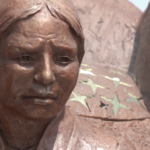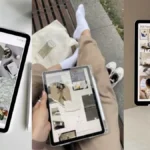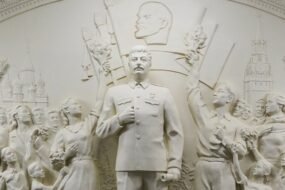
Degas’s “Wounded Jockey” has tumbled from his horse. Boccioni paints the animal as eddying rainbow curves in “Plastic Forms of a Horse”. Raymond Duchamp-Villon, during the first world war, sculpts “The Horse” into a killing machine. But the fount of these and many other anti-monuments in the exhilarating, revelatory and extremely affecting exhibition Medardo Rosso: Inventing Modern Sculpture at Basel’s Kunstmuseum is an artist barely known outside his native Italy.
Rosso’s “Bookmaker”, stylish in top hat and frock coat, binoculars clasped to his chest, merely leans forward to watch riders and runners at the Paris races in 1894, but each time you meet him — five versions are dotted across the show — his perilous sloping stance, destabilised as if he’s losing his footing in the sculpture’s billowing ground, looks more insistently anti-heroic and parodic. We hardly catch his features, but this fat, forlorn falling figure attracts our concern. Will he — will sculpture itself — remain upright?
Rosso’s tender, tilted heads and eccentric, swaying figures, modelled in plaster and wax, burst with such life, empathy and immediacy that it’s hard to believe their creator has been dead and forgotten for almost 100 years.

Basel plunges you into the crowd of these awkward, intimately realised characters glimpsed on the move. “Man Reading”, engrossed in his newspaper, totters along a wavy street. The face of “Laughing Woman” slips away in one huge extrovert grin. A heart-rending puffy-cheeked baby, “Child in a Soup Kitchen”, is enveloped in the wild shreds of a ragged plaster shawl. “Sacristan” slumps in a drink-fuelled haze, and the hunched old man in “Sick in Hospital” loses his grip on life as his splendidly craggy chair veers away from him.
It’s fresh, original and, as Basel teases out in colourful dialogues, heralds the future. Rosso’s “Sick Child”, inclining oval face, closed eyes, abstracted features — the wax over plaster version is translucent, underlining vulnerability — is a dead ringer for Brancusi’s streamlined egg-shaped “Sleeping Muse”. Rosso also influences Modigliani’s serene ovoid faces, the futurists, arte povera, Giacometti’s ephemeral figures, Alina Szapocznikow’s diaphanous polyester “Head of Piotr”, Juan Muñoz’s mask “Rosso in Africa”.
Realist and anarchist, impressionist, expressionist, determined to shove sculpture off the plinth and on to the street, Rosso was born in rapidly industrialising Turin in 1858, and began in the 1880s sketching urban existence, fugitive glances, fleeting figures, set down in the fragile, malleable media of plaster and wax to create “a moment’s monument”.

His first model was his affectionate, irascible “Concierge”: sagging skin, frowning brow, hollow temples, slouching posture distorting into an illegible mass. Rosso portrayed “that blasted old creature who keeps me from getting anything done” in a fit of pique: “Angrily I go down to her room with my clay. I start working fast. I had in mind the effect that she had always made upon me as I went by and looked at her in passing. I managed to snatch that moment from life.”
Soon these relief-like forms became more improvised, lacking backs because Rosso despised “the objectivisation that makes things one can walk around”; the viewer finding focus was part of the experience. So through whirlpool surfaces of folds and fingerprints, plays of light and shadow, he rendered faces and effacement, figures emerging from amorphous mounds to crystallise into unlikely portraits, including in “The Conversation” his own: a mysterious standing man in a cloak, seen from behind, in retreat though part of a continuum with women in long dresses seated on a bench.

The blur and unfixed edges are crucial. In “Aetas aurea” Rosso’s wife embraces their baby, indistinct contours uniting the faces, the mother’s hand kneading the child’s cheek as if she were shaping it, like a sculptor. Exquisite child heads such as the soft wax “Jewish Boy” shift in expression, melancholy, bewildered, resilient. Their delicate grace recalls quattrocento profiles, although Rosso hated Renaissance representation: travelling through Florence by train he shielded his eyes.
Much that makes Rosso open, radical and heartfelt also contributed to his obscurity. Unlike Rodin, he did not create huge monuments or museum-scale pieces, and his poor materials of plaster and wax left his works as physically unprotected as the ordinary lives they depict. “Impression of an Omnibus”, five almost life-size plaster passengers heading to or from work — greengrocer, porter, man asleep — is known only from photographs because it broke in transit to an exhibition in Venice. Rosso was so stroppy that he was not asked back to the city until the 1914 Biennale when, neglecting to reply to the invitation, he turned up to find his gallery taken.

Another lost plaster group, “Paris the Night”, shows several figures vanishing into the dark — the appearance of disappearance. Installed in a garden, it weathered and decayed; surviving photographs enhance the sense of ghostly presence/absence.
Unworldly, passionate and accident-prone, Rosso hardly helped himself. Arriving in Paris in 1889, he fell ill through starvation and was rescued from hospital by Henri Rouart, Degas’s friend, who happened to see a Rosso in a shop and enquired about him. Rosso thanked him with an extraordinary hybrid between a bust and a knee-length portrait: small head, enormous torso draped in an artist’s smock, elongated arms hugging the body as Giacometti’s figures would do. It is here in plaster and bronze, gripping, bizarre — though you see why Rouart never bothered to collect it from the foundry.

Without a dealer, Rosso, struggling in Paris, hurtled around Europe seeking collectors. He fell off a tram en route to his exhibition in Vienna; recovering, he learnt that the aristocratic Lanckoronski family had seen his works but bought nothing. Off he rushed to their palace, rapidly unpacking his sculptures and installing them in place of the Roman busts in the atrium, vainly advocating that his were better.
After 1900, Rosso spent his time obsessively restaging his sculptures as photographs, but a last commission in London, from the Mond family for their son’s portrait, returned a flash of brilliance. For days he stayed with the Monds, producing nothing — edgy, nervous, overstaying his welcome; then, at an evening reception, he saw the child peer out for a second from behind a curtain, lips parted in astonishment. Rosso worked through the night to capture that glimpse, and in rapturous sfumato marks half veiling the awestruck face, surging blond hair, shiny forehead, as the curtain had done, he created “Ecce puer”, a luminous “vision of purity in a banal world”.

Rosso was avowedly secular but the religious title suggests belief in sculpture’s capacity for revelation. “Art must be nothing else than the expression of some sudden sensation given to us by light,” he once said. In his glorious work, it is.
To August 10, kunstmuseumbasel.ch
Find out about our latest stories first — follow FT Weekend on Instagram and X, and sign up to receive the FT Weekend newsletter every Saturday morning









